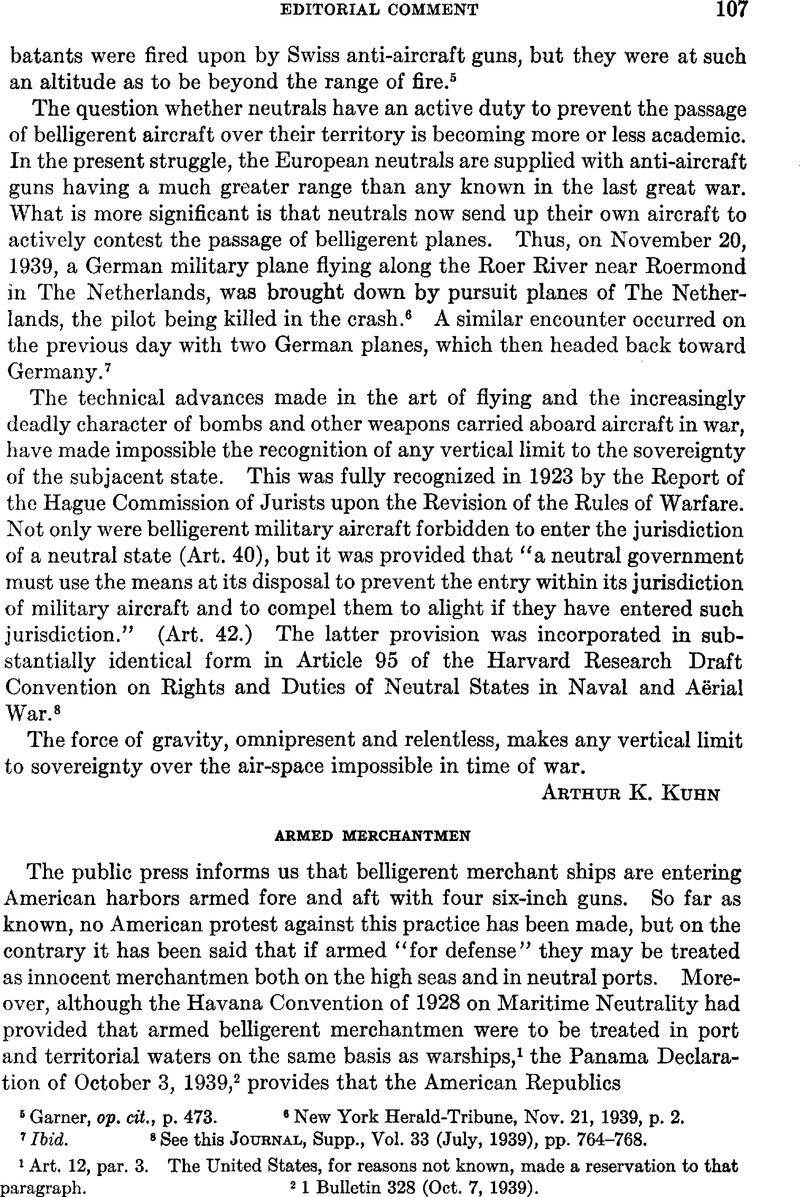Article contents
Abstract

- Type
- Editorial Comment
- Information
- Copyright
- Copyright © American Society of International Law 1940
References
1 Art. 12, par. 3. The United States, for reasons not known, made a reservation to that paragraph.
2 1 Bulletin 328 (Oct. 7, 1939).
3 For. Rel., 1914, Supp., 611-612. Lansing thought that if armed “for the sole purpose of defense,” the ship did not acquire “the character of a ship of war,” that while the presumption was that any armament was “for offensive purposes,” the presumption could be overcome, and he then set out certain criteria of “defensive” armament, including the size of the guns, their limited number, “that no guns are mounted on the forward part of the vessel,” that the ammunition is small, that the vessel is manned by its usual crew, that its fuel and supplies are sufficient to carry it only to its port of destination, etc. The New York Times, Dec. 2, 1939, reports that Rumania has forbidden access to its ports or territorial waters to all belligerent ships armed with more than two six-inch guns. The dispatch adds that “the armament . . . must be for defense purposes only, and this fact must be obvious.” No test for determining this “obvious” fact is suggested. Belgium, Denmark, Norway, Sweden, and Iceland appear to admit belligerent merchant ships armed for “defense.” The uniform Scandinavian laws give no definition. French texts quoted (1939) 15 Revue des lois (Inst, Int. du Commerce), 213-214.
4 For. Rel., 1915, Supp., 849-850; 1916, Supp., 749.
5 Savage, The Policy of the United States Toward Maritime Commerce in War, Doc. No. 149, II, 430, 431.
6 The correspondence between British and Dutch Governments will be found in a British Blue Book, reprinted in this Journal, Supp., Vol. 12 (1918), p. 197 et seq.
7 Savage, op. cit., 431-432.
8 For. Rel., 1916, Supp., 147.
9 9 Cranch 388, at 430 (1815). It has been assumed by some defenders of armament on merchant vessels that Marshall did not believe that the armament exposed the vessel and her neutral cargo to the danger of sinking. But this hardly does credit to Marshall’s intelligence. After the ship was captured—not sunk—he held, contrary to Stowell’s view in The Fanny (1814), Dobson, 443, 448, Moore’s Dig., VII, 491, that neutral cargo was immune from condemnation, notwithstanding the risks its carrier had run. The court divided 3 to 2 on that issue; but we know that Marshall was anxious to preserve and extend the rights of neutrals. Privateers did not sink prizes unless absolutely necessary, for obvious reasons; and privateers were occasionally themselves captured or sunk by armed merchantmen. All the judges agreed that the Nereide, armed with ten guns, could have made lawful captures. Clearly, then, she was subject to the danger of being sunk, even if only while attempting to escape the privateer. Nothing else could have been meant by Marshall when he speaks of the Nereide as “an open and declared belligerent, claiming all the rights and subject to all the dangers of the belligerent character.” Cf. Moore, John Bassett, “Fifty Years of International Law,” 50 Harv. L. Rev. 395, at 437-442 (1937)CrossRefGoogle Scholar. Professor Hyde states that Lansing merely applied an old rule to existing conditions. International Law, II, 467. On the history of arming merchantmen, see Vivaud, , Jean, , Les navires de commerce armés pour hur défense (Paris, 1936), p. 15 Google Scholar et seq.
10 The two resolutions differed somewhat. Cf. Borchard and Lage, Neutrality for the United States, 113-117.
11 That memorandum has been criticized in Borchard and Lage, op. cit., 117 et seq.
12 See Hyde, , International Law, II, 469–472 Google Scholar. Art. 28 of the Research in International Law (1939) provides:
“A neutral State shall either exclude belligerent armed merchant vessels from its territory or admit such vessels on the same conditions on which it admits belligerent warships.” See also Art. 2 and comment. This Journal, Supp., Vol. 33 (July, 1939), pp. 224 et seq., 335 et seq.
13 An officer of the armed Anchor Liner Cameronia, remarking on the fact that she had been repainted a buff color to mislead German submarines into thinking her a neutral ship, is reported to have said, “They have to come up to us to make certain, and then we’ll let them have it.” New York Times, Nov. 15, 1939. Mr. Bryan, on June 2, 1915, then at odds with Mr. Lansing on the armed ship question, advised President Wilson, correctly, that “the character of the vessel is determined, not by whether she resists or not, but by whether she is armed or not . . . the fact that she is armed raising the presumption that she will use her arms.” Baker, Wilson, Woodrow, Life and Letters, V, 354 Google Scholar, quoted in article of J. B. Moore, loc. cit., p. 439.
The 6-inch gun is a heavy gun. At the Washington Conference it was agreed that no warships should be built, other than battleships, with gun caliber over 8 inches. Article XII of General Convention, Proceedings, p. 1580. All but the heaviest British cruisers carry a maximum caliber gun of 6 inches. Cf. 1935 Naval Conference, Documents, pp. 806, 811, 851. The Ajax and the Achilles, which placed the Graf von Spee hors de combat, carried 6-inch guns as a maximum.
14 These rules came into force for the United States, Great Britain and Japan. Proceedings of the London Conference, 1930, Conf. Ser., No. 6 (Washington, 1931), Art. 24 (2), p. 219; Hazlett, Submarines and the London Treaty (1936), U. S. Naval Inst., Proc, p. 1691. Even the 1936 Naval Treaty, now subscribed by France and Italy and many other countries, cannot be deemed to have extended these immunities to armed merchant vessels. Cf. Borchard and Lage, op. cit., pp. 193-196.
- 1
- Cited by




